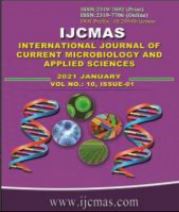


 National Academy of Agricultural Sciences (NAAS)
National Academy of Agricultural Sciences (NAAS)

|
PRINT ISSN : 2319-7692
Online ISSN : 2319-7706 Issues : 12 per year Publisher : Excellent Publishers Email : editorijcmas@gmail.com / submit@ijcmas.com Editor-in-chief: Dr.M.Prakash Index Copernicus ICV 2018: 95.39 NAAS RATING 2020: 5.38 |
The general objective of this work is to provide useful information to the scientific world on the extrinsic physical factors of starches which could influence the determination of the water absorption capacity and the water solubility index in order to help them to properly assess the industrial qualities of foods. It therefore consisted in varying the solvent, the incubation temperature, the centrifugation time and the concentration of the starch in the reaction medium during the determination of the water absorption capacity and the solubility index in the water according to the granulometry of the cassava starch Manhiotesculenta cv Bonoua 2. Particles whose sizes are less than 250 µm are the most represented in the total dry ground of cassava root Manhiotesculenta cv Bonoua 2. The water absorption capacity and the water solubility index vary significantly (p<0.05) depending on the particle size and the détermination parameters. Tap water decreases the water absorption capacity while it increases the water solubility index. At incubation temperatures above 55 ° C, the water absorption capacity and the water solubility index increase considerably. The centrifugation time greater than 10 min at a speed of 5000 rpm leads to a decrease in the water absorption capacity but promotes an increase in the water solubility index. The water absorption capacity increases with the concentration of starch, while the water solubility index decreases with the increase in the concentration of starch.
 |
 |
 |
 |
 |